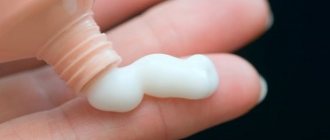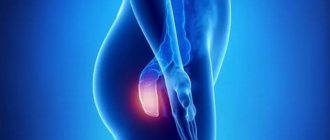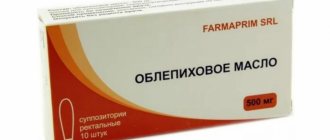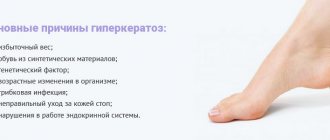Hemorrhoids are a vascular disease in which dilation of the hemorrhoidal veins of the rectum is observed, causing the formation of characteristic hemorrhoids that cause pain and bleeding in patients.
Diagnosis of hemorrhoids is not difficult: more than 90% of cases are determined during a digital examination of the anus and do not require the use of instrumental research methods.
Causes
The root cause of hemorrhoids is a violation of the inflow and outflow of blood in the cavernous bodies of the rectum. Normally, the corpora cavernosa (also called cavernous bodies) help control the urge to defecate: when filled with blood, they “swell” and help retain feces in the intestines, and after a successful bowel movement, blood flows out and the corpora cavernosa shrink.
If the inflow/outflow regulation is disrupted and the corpora cavernosa have been engorged with blood for a long time, this causes the vascular walls to dilate and thin, making them much more susceptible to rupture or erosive lesions, which in turn cause inflammation and can lead to blood clots.
Factors that provoke venous stagnation
The following predisposing factors can provoke long-term venous congestion in the corpora cavernosa:
- Physical inactivity.
A low level of physical activity (due to sedentary work or simple laziness) causes extensive disturbances of venous blood flow throughout the body - and in the rectum in particular.
- High loads.
Ultra-high physical activity associated with lifting weights causes excessive tension in the abdominal muscles and rectal area, which also leads to disturbances in the venous blood flow.
- Chronic constipation.
The presence of feces in the rectum causes a constant, permanent filling of the cavernous bodies with blood, as mentioned above.
- Venous pathologies.
Impaired blood flow in hemorrhoidal veins can be caused by various vascular diseases.
- Oncology.
Tumor formations in the rectum cause disturbances in the inflow/outflow of blood due to mechanical compression of the venous vessels or their deformation due to tumor growth (in later stages).
- Diarrhea.
Severe diarrhea, especially caused by poisoning or infectious diseases, causes congestion of the venous system of the rectum, which leads to dilation of blood vessels or even micro-ruptures, followed by an inflammatory process.
- Pregnancy and childbirth.
Bearing and giving birth to a child is often accompanied by multiple disturbances in the pelvic venous circulation system, which can (but not necessarily) lead to the appearance of hemorrhoids.
- Obesity.
The presence of excess weight, by analogy with physical inactivity, also leads to multiple disturbances of venous blood flow.
- Bad habits.
Chronic alcohol abuse or long-term tobacco smoking provokes varicose veins, which primarily affects the pelvic region and lower extremities.
- Heredity.
Low hereditary elasticity of the venous vessels of the rectal area creates a predisposition to hemorrhoidal disorders - although it is not considered as their direct cause.
Relief ®
This is a whole list of products of different compositions and with the main active ingredient shark liver oil. Manufacturers for hemorrhoids produce:
• Relief. An additional component of the product is phenylephrine hydrochloride. Belongs to the group of vasoconstrictor substances. The action is aimed at reducing swelling and tension of hemorrhoids.
• Along with shark liver oil, Relief Ultra contains a glucocorticosteroid, a hormonal substance, as a result of which the product has pronounced anti-inflammatory activity.
• In addition to the main component, Relief Advance contains the anesthetic benzocaine. This is a powerful pain reliever.
Suppositories and ointment without a hormonal component are prescribed up to 4 times a day, and the Ultra form - up to 2 times. Before administering the product, it is necessary to cleanse the intestines. It is better to do this naturally and only in exceptional cases use an enema. The course of treatment is determined individually. If glucocorticosteroid hormones are used for hemorrhoids, the use of the medication should not exceed 6 days.
Symptoms
The main signs of hemorrhoids are bleeding from the anus, as well as pain, itching and discomfort in the rectal area. The severity of symptoms differs depending on the form of the disease (acute or chronic), as well as its stage (neglect).
Signs of chronic hemorrhoids
The nature of the symptoms is determined by the stage of the disease:
- Stage 1.
As a rule, there are no disturbing signs, and the presence of hemorrhoids can only be detected with targeted research. In rare cases, patients complain of occasional pain and itching in the anus or minor traces of blood on toilet paper.
- Stage 2.
Visually visible and easily palpable hemorrhoids appear, which still retain a certain “elasticity” and therefore do not fall out of the rectum. Bleeding, pain, itching and discomfort in the rectal area do not always bother patients; sometimes the disease is still asymptomatic.
- Stage 3.
Hemorrhoids protrude and often bleed. Pain and itching become constant, intensifying with bowel movements or physical activity. Thrombosis of hemorrhoidal veins may occur.
- Stage 4.
Hemorrhoids become large, constantly hurt and bleed. Primary signs of tissue necrosis may also be observed.
Symptoms of acute hemorrhoids
The acute form of hemorrhoids occurs against the background of complete or relative well-being, when there were no hemorrhoidal formations at all or if the disease was asymptomatic. The transition to the acute stage is accompanied by the following symptoms:
- sudden sharp pain, most often occurring during bowel movements;
- heavy bleeding as a result of rupture of a venous vessel;
- severe itching and discomfort that does not disappear even after completion of the bowel movement;
- the appearance of visible and severely inflamed hemorrhoids - if these have not been observed before.
Available treatments for hemorrhoids
Non-drug therapy does not work as quickly as desired, and surviving an exacerbation is quite difficult, given the nature of the symptoms. It is the medications that will help to quickly relieve the signs of the disease.
The list of medications is long. The following may be prescribed for treatment:
• Suppositories for early hemorrhoids.
• Ointments or creams to relieve symptoms of hemorrhoids.
• Tablets or capsules for severe hemorrhoids.
A list of the most popular treatments is presented below.
Troxevasin ® for hemorrhoids
The product has been used for a long time and has proven its effectiveness. The active component of the product is troxerutin, which is associated with all of the following properties of Troxevasin:
• Anti-inflammatory.
• Decongestant.
• Venotonic.
• Anticoagulant.
• Antioxidant.
It is recommended to apply ointment for hemorrhoids 2 times a day. For external hemorrhoids, you can make compresses or bandages from gauze soaked in the product. The doctor will tell you how much to treat the pathology in each specific case.
Proctoglivinol and Gepatrombin ® products
Suppositories sold under the name Proctoglivenol contain two active ingredients. The analgesic effect develops due to lidocaine, and the improvement in the structure of the vascular wall is due to the tribenoside included in the composition. Directions for use: 1 suppository 2 times a day during an exacerbation. As the symptoms subside, switch to a maintenance dose - 1 supp. 1 r/day.
Hepatrombin G is a remedy for complications. These suppositories have anti-edematous, antithrombotic, regenerative, anesthetic and anti-inflammatory effects. They are carried out using the following funds:
• Lauromacrogol.
• Prednisolone.
• Heparin.
Suppositories are prescribed 1-2 times a day. The course for hemorrhoids is determined individually.
Classification of phlebotonic drugs
Modern tablets allow you to treat external hemorrhoids and relieve pronounced symptoms of the disease at any stage. According to clinical trials and patient reviews, the most effective means in the fight against anal varicose veins are:
- Phlebodia is a new generation drug based on plant components of bioflavonoids. The active ingredient diosmin has a venotonic, angioprotective effect on venous vessels, increases lymphatic drainage, strengthens the walls of veins and reduces their permeability. Tablets are indicated for acute and chronic forms of the disease. Contraindications: allergy to the components of the tablet, age under 18 years, 1st trimester of pregnancy and lactation period.
- Detralex is a tablet based on diosmin and hesperidone, which has a complex effect in several directions at once: increasing venous tone, eliminating blood stagnation, normalizing microcirculation of lymph and blood, as well as giving elasticity to blood vessels. Indications: exacerbation of external hemorrhoids, varicose veins of the lower extremities, general prevention of venous insufficiency.
- Venarus – hesperidin and diosmin in tablets. It has the same effects as previous medications. With regular use, it helps to normalize blood flow in the pelvic organs, maintains the elasticity and reliability of the venous wall, and eliminates blood stagnation. Tablets are effective in complex treatment of the problem.
- Vazonit is a medicine based on the active substance pentoxifylline. Helps normalize microcirculation of the venous vessels of the rectum and anus, improves oxygen supply to tissues. The tablets reduce the risk of blood clots in external hemorrhoids, which minimizes the risk of complications. Dispensed with a doctor's prescription.
Zinc ointment ®
The product helps to effectively overcome the disease. Zinc ointment is produced by various pharmacological companies under different brands, so when purchasing, you should pay attention to studying the information about the percentage of the component in the ointment. To ensure proper effectiveness, it must be at least 20%.
In some cases, in order for medications to remove hemorrhoids even faster, manufacturers add additional active substances to the topical product. They can be beeswax, local anesthetics (lidocaine, benzocaine), mineral oils. Zinc ointment has astringent and antiseptic properties, while the rest depends on additional ingredients. You need to use the product 1-2 times a day, taking into account the recommendations of your doctor.
Ointments Bezornil, Aurobin and Levomekol ®
An equally effective method to help treat pathology is the use of ointments or creams, for example Bezornil. The product for local therapy contains musk of artificial origin (muscone), bezoar, calamine, pearls and amber. The components provide antimicrobial, astringent and drying effects. You need to use ointment for hemorrhoids at least 2 times a day, and preferably after each bowel movement.
Aurobin for hemorrhoids. The product contains lidocaine, D-panthenol (regenerating), triclosan (antiseptic), prednisolone (potent anti-inflammatory effect). Used for hemorrhoids 2 times a day for a course of no more than 5-6 days.
Levomekol for hemorrhoids. One of the safest means for external drug therapy, approved for use even in pregnant and lactating women. The main active components of Levomekol are methyluracil, which has regenerative and moderate immunostimulating effects (due to activation of interferon synthesis), and chloramphenicol, an antimicrobial substance. On average, you need to be treated with Levomekol for 9-10 days, applying the ointment 2-3 times a day.
Surgical methods for treating hemorrhoids
Drug therapy helps block incipient hemorrhoids. In cases where stages 3-4 are diagnosed, it is difficult to treat exclusively with medication. In this situation, they resort to surgical correction, that is, an operation to remove hemorrhoids.
Hemorrhoidectomy
The most applicable procedure for hemorrhoids. The intervention was developed by surgeons of the last century Morgan and Milligan. There are several modifications or methods of performing the operation:
• Classic. It involves complete removal of the nodes using available surgical instruments (nowadays, lasers and electrocoagulators are more often used to reduce blood loss). Not only the nodes themselves are subject to excision, but also the underlying mucosal tissue, which increases the healing time and makes the operation more traumatic. Rehabilitation with the classical method of intervention can take about 1 month.
• Closed. Introduced somewhat later by Ferguson and therefore bears his surname. It differs from the first option in that the intervention ends with tissue suturing, which shortens the rehabilitation period.
Ligation and coagulation
Hemorrhoidectomy is not the only option for surgical removal of hemorrhoids. The list is long. One commonly used method is ligation. It is performed using special rings made of latex, or by applying sutures. As a result of the procedure, the blood supply to the node is stopped, its walls collapse, and over time it falls off, leaving a scar. After the node falls off, the latex ring is excreted in the feces.
The list will continue with coagulation. Electro- or photocoagulation is used. The first procedure for hemorrhoids is performed using electric current. Intervention, unfortunately, does not provide a 100% guarantee of recovery.
Without taking adequate measures to prevent recurrence of hemorrhoids. In some cases, scar deformation, pain, and sphincter spasms may occur. Photocoagulation is good for primary hemorrhoids. Bleeding is considered a complication of the procedure, and the disadvantages include the fact that only 1 node can be treated in this way per 1 intervention.
Sclerotherapy, disarterization and cryodestruction
Sclerotherapy consists of introducing a special substance into the lumen of the nodes - sclerosant. As a result of treatment, the lumen of the vein “collapses”. Complications are rare.
Hemorrhoids can also be removed using cryodestruction. The method is based on the effect of low temperatures on the pathological focus. Cryodestruction will help eliminate the disease at any stage of the disease. For initial hemorrhoids, it does not require hospitalization.
Currently, a method such as disarterization is often used. During the intervention, the blood vessel feeding the hemorrhoids is ligated. Blood no longer flows into the pathologically dilated veins and they gradually “collapse.” The procedure does not require long-term rehabilitation and allows you to relieve hemorrhoids in the shortest possible time.
The list of radical treatment methods will be completed by Longo surgery. The intervention is carried out using a specially created device, and the time spent on the procedure rarely exceeds 25-30 minutes. Unfortunately, the method is only suitable for relieving internal hemorrhoids.









